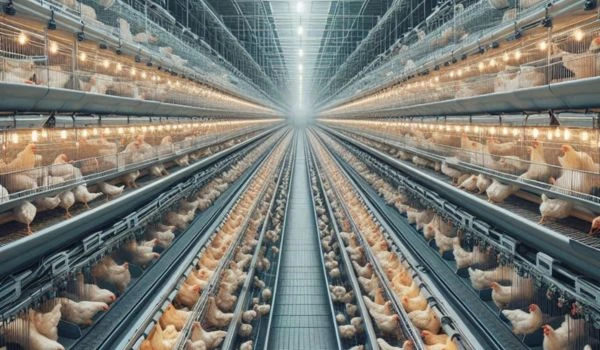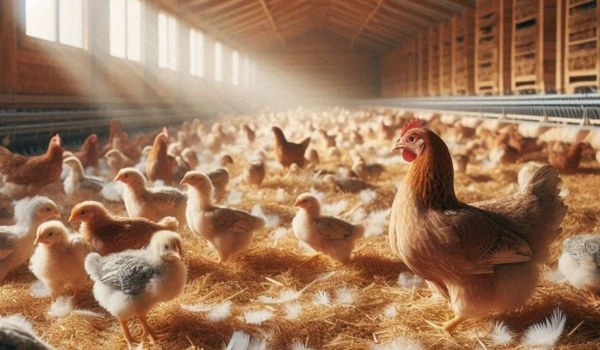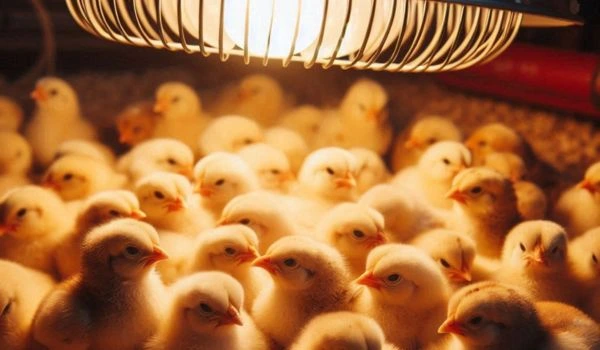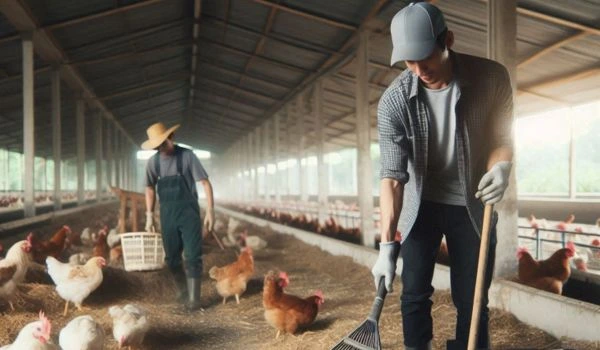Poultry farming is one of the most rewarding forms of agriculture, allowing farmers to raise chickens and other birds for meat, eggs, and feathers. Whether you are new to farming or have some experience, understanding the different systems of poultry farming and how to manage birds effectively is key to success.
In this guide, we’ll explore the two most common poultry farming methods—Cage System and Deep Litter System—along with important practices like confinement rearing, brooding, and litter management.
Poultry Rearing Systems
In India, poultry farmers generally use two systems of poultry rearing:
- Cage System
- Deep Litter System
Each method has its own advantages and disadvantages, and the choice between them depends on factors such as climate, farm size, and the specific goals of the poultry farmer.
When setting up your poultry farm, one of the first decisions you’ll face is choosing the right rearing system for your birds. In India and many other parts of the world, poultry is commonly raised using either the Cage System or the Deep Litter System.
Let’s explore what these systems are, their advantages, and how they can be applied in different farming conditions.
Cage System

The Cage System is an intensive method of poultry farming where birds are kept in cages. These cages are made of metal or wire mesh and arranged in rows or tiers.
Each bird is provided with a specific amount of space (around 450-525 square centimeters, or about 0.6 to 0.75 square feet per bird) to ensure they have room to move around without overcrowding. Usually, 2 to 3 birds are housed per cage, and this system is widely used in egg-laying farms.
Advantages of Cage System
- Efficient use of space: Because the birds are kept in cages, you can house a large number of birds in a smaller area, making this system ideal for farmers with limited space.
- Easy monitoring and management: Keeping birds in cages allows you to monitor their health, food intake, and egg production individually. You can quickly identify sick birds and cull those that are not laying eggs efficiently.
- Cleaner environment: Since the birds don’t have contact with the ground or litter, the eggs remain cleaner and there’s less chance of contamination from manure.
- Reduced fighting and injuries: Birds kept in cages are less likely to injure each other compared to birds kept in free-range systems. Problems like cannibalism and egg-eating are also minimized.
- Lower risk of parasitic infections: The cage system helps control diseases caused by parasites such as coccidiosis (a disease that affects the intestines) and worm infestations, as the birds are not in direct contact with the ground.
Disadvantages of Cage System
- Higher stress levels: Birds kept in cages can experience higher levels of stress because they have limited movement and social interaction. This can affect their overall health and productivity.
- Leg and bone problems: Birds confined in cages for long periods may develop conditions like cage fatigue, which leads to weak legs and bones due to a lack of exercise and inadequate nutrition.
- Ventilation challenges: Proper ventilation is crucial in cage systems. In hot climates, poorly ventilated poultry houses can lead to heat stress, which negatively affects egg production and the overall health of the birds.
- Environmental issues: Cage systems can generate large amounts of manure in a confined area, which needs to be managed properly to prevent environmental pollution.
Who should use the Cage System?
The Cage System is ideal for farmers who want to focus on egg production in moderate climates and have limited land space. It’s especially suited for commercial-scale farms where the primary goal is to maximize egg production and efficiency.
Deep Litter System

The Deep Litter System is a more traditional method of poultry farming where birds are kept on the ground in a large, open space. The floor of the poultry house is covered with a layer of litter material such as paddy husk, sawdust, chopped straw, or groundnut shells.
This system allows the birds to roam freely, scratching at the ground, which encourages natural behaviors and helps them stay healthy. The litter absorbs moisture from the bird’s droppings and should be managed regularly to maintain cleanliness.
Advantages of Deep Litter System
- Natural environment for birds: Birds have more room to move around and express their natural behaviors, such as scratching, dust-bathing, and social interaction. This leads to healthier, happier birds.
- Cost-effective setup: The initial investment for a deep litter system is lower than a cage system because it doesn’t require expensive cages. You simply need a well-ventilated house and the right litter material.
- Nutrient recycling: The litter material, when mixed with bird droppings, eventually turns into compost that can be used as organic fertilizer for your crops.
- Better disease control with proper management: When the litter is managed properly (kept dry and stirred regularly), it can help control the spread of diseases and improve the health of the birds.
- Good for large-scale operations: The Deep Litter System is ideal for farmers who have large flocks of birds and want to raise them in a more natural, free-range environment.
Important Considerations for Deep Litter System
- Maintain proper ventilation: A well-ventilated poultry house is essential to keep the litter dry and prevent the buildup of ammonia from the bird droppings, which can harm the birds’ respiratory systems.
- Litter management: The litter must be stirred weekly and replaced if it becomes too wet or dirty. This helps prevent the spread of diseases like coccidiosis and salmonella.
- Stock density: Avoid overcrowding by ensuring there is enough space for each bird. Overcrowding can lead to increased stress and the spread of diseases.
- Monitor bird behavior: Since birds in a deep litter system can move around freely, it’s important to observe their behavior and quickly address any signs of illness or stress.
Who should use the Deep Litter System?
The Deep Litter System is ideal for small to medium-scale poultry farmers who have more land and want to raise birds in a natural, low-cost environment. It’s also suitable for farmers in regions with good ventilation and dry weather conditions.
Confinement Rearing and Brooding
Confinement rearing refers to housing birds in controlled environments for better management and productivity. The size of the flock can significantly affect profitability, with larger units being more economical.
Brooding refers to the process of caring for young chicks by providing them with warmth, food, and protection until they are old enough to fend for themselves.

Brooding is crucial in the early stages of a chick’s life. Newly hatched chicks require warmth and care until they grow feathers, usually up to 4-5 weeks.
The use of artificial brooding—which involves providing supplementary heat, such as electric bulbs or infrared lamps—can ensure that chicks stay healthy and active.
Brooding Essentials
- Temperature management: Chicks are extremely sensitive to temperature changes. In the first week, the brooding area should be kept at around 35°C (95°F). As the chicks grow, reduce the temperature by 2-3°C each week until they no longer need external heat.
- Space and comfort: Chicks need adequate space to grow and move around. At one week of age, you should provide 0.2 square feet per chick. Increase the space as they grow to avoid overcrowding and ensure their comfort.
- Litter: Use soft, absorbent materials such as sawdust or paddy husk for the brooding floor. maintain a depth of 5 cm, building up to 15 cm over time. Keep the litter clean and dry to prevent infections.
- Temperature control: Monitor the temperature closely, starting at 35°C in the first week and gradually lowering it as the chicks grow.
Proper brooding ensures that chicks grow into healthy, productive birds. Artificial brooding using electric bulbs or infrared lamps is common, especially in commercial farming.
Selecting Quality Chicks
The success of your poultry farm heavily depends on the quality of the chicks you start with. Poor-quality chicks will lead to poor results, no matter how well you manage the farm.
The quality of the chicks you select plays a vital role in the success of your poultry farming. No amount of good management can compensate for poor-quality chicks.
Always procure chicks from reliable sources, and ensure that you purchase more than the required number to account for normal losses due to mortality or culling.
When selecting chicks:
- Purchase from reliable hatcheries.
- Choose day-old chicks that are healthy, active, and free from any visible defects.
- Overbuy chicks to account for losses from mortality or culling.
For commercial egg production, you may need to buy 1100 chicks for every 1000 layers. For broiler farming, plan for 250 chicks per batch to market at 6-7 weeks of age.
Litter Management and Lighting

Managing litter in both the Cage and Deep Litter Systems is critical for bird health. A poorly maintained litter can become a breeding ground for harmful bacteria and parasites. Here’s how to keep the litter in top condition:
- Keep it dry: Regularly check and stir the litter to keep it dry. If the litter becomes too wet, replace it immediately.
- Use natural disinfectants: Sprinkling dry lime on the litter can help neutralize ammonia buildup and reduce odors.
- Lighting for broilers: Provide dim lighting (40-watt bulbs for every 250 chicks) during the night to help the birds feed and drink without being stressed by bright lights.
In summary, starting a poultry farm or improving your current operation can be a highly rewarding venture if managed correctly. Whether you choose the Cage System or the Deep Litter System, proper management is key to ensuring the health, well-being, and productivity of your birds.
Pay attention to factors like brooding, litter management, and space allocation to ensure your farm runs smoothly. Following these guidelines, you can make poultry farming a profitable and sustainable business.

